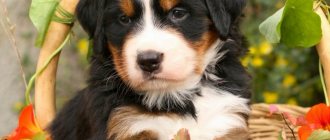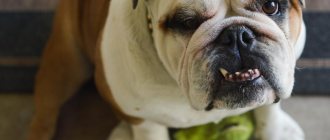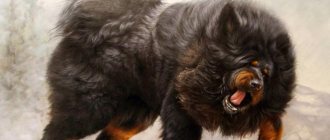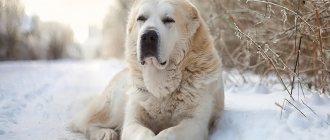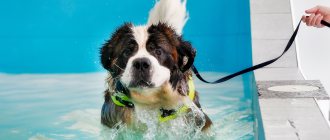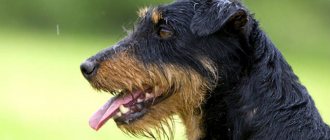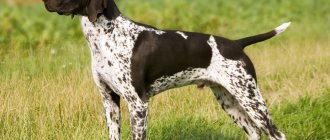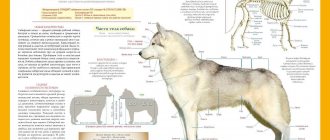History of the Entlebucher Mountain Dog breed
Charming Entlebucher Mountain Dogs
The breed received its difficult-to-pronounce name in honor of the Entlebuch Valley, located in the Swiss cantons of Bern and Lucerne. At first, small herding dogs were classified as members of the Appenzeller Mountain Dog clan, which had the same working qualifications and identical coat color. And only in 1913 the breeds were differentiated by entering the Entlebuchers in the stud books as an independent variety of Swiss Mountain Dogs.
With the outbreak of the First World War, work on “improving” the exterior and working qualities of animals came to naught. And when, a few years later, breeders again became interested in Entlebuchers, it turned out that only a few of the purebred “specimens” survived the war. Dr. B. Kobler was most actively involved in restoring the population of small mountain dogs. For the sake of a purebred pair of sires, the breeder-enthusiast traveled all over Switzerland, ultimately settling on a female named Babel, who gave rise to the modern branch of entleys.
The first breed club opened in 1926. A year later, its representatives underwent standardization, receiving the official right to breed and participate in exhibition events. The development of the Entlebucher Mountain Dog genus proceeded quite slowly, so standard individuals in terms of appearance and temperament began to appear only in the second half of the 20th century. One of these exemplary dogs was the dog Much, an international champion, who in the 60s collected all the prizes at Swiss, German and international breed exhibitions.
Brief history of origin
Like other Swiss dog breeds, the Entlebucher Mountain Dog has evolved over several centuries. It traces its origins to the ancient Roman fighting dogs Molossians, whose blood flows in the veins of many modern Great Danes.
According to the official version, the Entlebucher Mountain Dog appeared in the Middle Ages. Due to the rapid development of livestock farming, people no longer need large guard dogs and there is a demand for small herding dogs.
As a result of many years of selective selection, a tightly built and unpretentious Entlebucher Mountain Dog was formed. Initially it was considered a type of Appenzeller. And the breed was recognized as an independent breed only after the exhibition, which took place in 1913 in Lagental.
13 years later, the Swiss Club of Entlebucher Mountain Dog lovers was organized.
Entlebucher Mountain Dog breed standard
Entlebucher Mountain Dog puppies
The Entlebucher is a compact, smooth-haired, handsome dog that seems to have been slightly stretched in length. Color played an important role in creating the memorable image of the breed: rich red-and-white spots in combination with an elegant black “tailcoat” give the appearance of the animal a gentlemanly gloss and slight aristocracy. In terms of size, the Entle is not such a baby as they like to imagine - all people from the Entlebuch Valley are of average height, have a strong constitution and weigh between 18-23 kg. The dogs only look miniature compared to their brutal Swiss relatives – Appenzellers and Bernese Mountain Dogs.
Head
The Entlebucher Mountain Dog has a harmoniously developed wedge-shaped head of a slightly dry type. The skull is flat, wide in the area between the ears and narrowed in the muzzle area. The occipital protuberances and stops are barely defined. The muzzles of entleys are massive, but not pointed at the lobe.
Bite and teeth
The reference type of bite, fixed by the standard, is full scissors. In this case, a pincer-shaped closure is allowed, although not very desirable. Also, the exhibition score is not reduced for the absence of 1-2 first premolars or third molars.
Nose
O yes! Scratchies
The lobe is colored uniformly black and protrudes slightly forward, hanging over the upper lip.
Eyes
The entle has small eyes of a regular round shape, covered with completely black eyelids. The color of the iris can vary from light brown to dark brown. The dog's gaze is attentive, inquisitive, and friendly.
Ears
The ears are small, but well spaced from each other and set high. The cartilage of the base is strong and massive. The ear flap is triangular in shape with a neatly rounded tip, hanging down. If the dog is worried about something, the base of the ear rises and its flap turns forward. A calm animal has ears pressed tightly to its head.
Neck
The dry but well-developed neck of the Entlebucher Mountain Dog is of medium length and blends smoothly into the body without forming protrusions.
Entlebucher Mountain Dog muzzle
Frame
Entlebucher Mountain Dog - a hardy dog
The body is strong, moderately elongated, with a deep chest, lowered to the elbows, and a tucked underline. The dog's back is flat and wide, the loin is flexible, but not shortened. The croup is distinguished by sloping outlines and sufficient length.
Limbs
Entlebucher Mountain Dogs' legs should combine power and flexibility without appearing heavy. Mandatory requirements for the forelimbs: long sloping shoulder blades with good muscles, elbows tightly fitting to the body, pasterns with slight angles (when viewed from the side). The Entlebucher's hips are wide, voluminous and quite long. The hocks are set low and well angulated; metatarsus short, strong, even. The dog's paws look quite interesting. Round, with arched, tightly knit toes and hard pads, they give the impression of calm solidity and strength.
Tail
All “Swiss” are born with both normal tails and a shortened version, both options are approved by the breed standard.
Wool
Entlebucher Mountain Dogs have a thick, warm undercoat hidden under a layer of short, close-fitting topcoat. In healthy individuals, the coat looks shiny and smooth, but slight wavy hair in the area of the withers is acceptable.
Color
The breed has a classic three-color color with a predominant proportion of black pigment and red-brown and white spots. Rufous markings are located above the eyes, on the muzzle, cheeks and throat, on both sides of the chest and on all four legs. Moreover, on the limbs, brown spots should occupy an intermediate position between areas with white and black fur.
Allowed types of white markings on Entlebucher Mountain Dogs
- A continuous narrow line running from the head along the midline of the nose and partially or completely covering the muzzle.
- Small white markings on all paws.
- A white stripe starting under the chin and ending at chest level.
- The tip of the tail is colored white (unless it is a shortened version).
- A small mark on the back of the head (the most undesirable, but nevertheless acceptable option).
Disqualifying faults
Entlebuchers at the exhibition
Not all representatives of the breed are born with impeccable external data. Sometimes animals have a number of shortcomings that do not affect the quality of life, but prevent them from gaining a champion title at exhibitions. A more serious variant of exterior defects is developmental defects. Individuals with them cannot be considered purebred and are not exhibited in the rings. For Entlebuchers, for example, the following are considered disqualifying defects:
- any colors except tricolor;
- ring-shaped tail design;
- severe crookedness, overshot or undershot;
- rolled or turned out eyelids;
- long and too soft wool;
- yellow or bluish color of the iris;
- any dominant color type other than black;
- height above 52 cm and below 44 cm in males, above 50 cm and below 42 cm in females;
- unreasonable cowardice and aggression.
Breed standard and description
Height at withers: males 44-50 cm, females 42-48 cm; Weight: 20-30 kg.
Color: tri-color, with a predominance of black and bright red tan.
Eye color: brown.
Nose color: black.
Lip color: black.
Tail: congenital short (bob tail) or long straight.
General appearance: strong, muscular and dry dog with floppy ears and short, double-layered coat.
Disqualifying faults:
- Entropion or inversion of the eyelids;
- Twisted jaw;
- Undershot or severe overshot;
- Tail in a ring;
- Single-layer, very long, soft wool;
- Yellow, blue or different eye colors;
- Cowardly or aggressive behavior;
- The color is not tri-color or its background is not black.
- Cryptorchidism in males.
Photo of Entlebucher Mountain Dog
Entlebucher Mountain Dog character
Entlebucher Mountain Dog with a child
Despite the fact that Entlebucher Mountain Dogs are formally “tied up” with herding and guarding activities, the working instincts of the breed have not disappeared anywhere and often remind themselves of themselves. A striking example of this is the dog’s attitude towards strangers and the territory in which it lives. A true entle will not allow a suspicious creature, be it a person or an animal, into his domain, and certainly will not start wagging his tail in front of a stranger when he persistently tempts him with a treat. By the way, the representatives of the family bark loudly and deeply, which does not fit in with their compact size.
A distinctive feature of a healthy purebred Entlebucher Mountain Dog is the desire for an active, eventful life, therefore, when you bring a tricolor “Swiss” into your home, get used to the fact that you will have to play with your ward often and a lot. You shouldn’t be too careful or afraid of your pet’s “hurricane” behavior either. Etlebuchers are not prone to destructive behavior, and a house turned upside down is not a story about them. Of course, there are exceptions to the general rule, but most often the destructive actions of an animal are associated with a lack of education or an incorrect relationship between the owner and the dog.
Together with a friend
The Entlebucher Mountain Dog is a sociable and sociable dog, but only within the family in which he lives. With members of the household, the pet has a blast, participating in any “movement” with the participation of familiar faces. For this reason, dog handlers recommend carefully metering the interaction of the four-legged rogue with children who are not at least 6-7 years old. The average entlebucher does not understand the difference between an adult and a child and sometimes sins with overly emotional jumping and “educational” biting on the legs - habits preserved from those immemorial times when his ancestors herded sheep.
The Entle has no particular desire to be friends with other animals, but if there is a live dog “party” planned, he will gladly take part in it. The breed also does not like to be rude, so if your ward is barked at by some wolfhound, a response to aggression will follow immediately. “Girls” are especially intolerant of provocations; they are many times more selfless in protecting the owner and members of his family in the event of a direct external threat.
Peaceful coexistence of the Etlebucher Mountain Dog with other dogs and pets is possible provided that all representatives of the fauna share living space from early childhood. For example, the lively natives of the Lucerne valleys are not averse to running with hounds in company. So if you keep representatives of other breeds at home, do not isolate them from the entle - let them learn to be friends and get used to each other.
Features of character and behavior
Representatives of the species are distinguished by curiosity, energy, and devotion to the owner and family.
Advantages
- The breed is famous for its kindness and sociability. Entlebucher does not show aggression, gets along with children, plays with them with pleasure and takes care of them. Dogs really love their family, enjoy participating in all joint activities and are very bored when left alone.
- As a rule, it rarely claims superiority both in relations with the owner and in interactions with other animals. Gets along well with pets and does not start fights in the dog park. Entlebuchers are sociable and make contact with new people and animals.
The breed is distinguished by a fairly high intelligence, masters commands well, strives to please its owner in everything, loves affection and praise.
The Sennenhund, thanks to its protective genes, will always defend its owner and his property in case of danger. He closely monitors anything suspicious and will definitely notify his owner by barking about anything unusual.
Flaws
- Representatives of the breed do not like to be left alone. Without company, a person may begin to whine and bark. It is important to start weaning off this habit from an early age and not leaving your pet alone for a long time.
- Entlebucher Mountain Dogs are very energetic, both at a young age and in adulthood, they need the opportunity to release energy, otherwise some pieces of furniture, clothing and shoes may suffer. It is better to raise anything fragile to an inaccessible height, not only from a bored animal, but also from a playing one - dogs of this breed do not sit still, run underfoot, try to actively participate in everything, and can accidentally touch valuable things.
Education and training
Entlebucher Mountain Dog training
On the one hand, the Entlebucher Mountain Dog is smart and savvy, but on the other hand, he is not always ready to demonstrate his outstanding abilities to others. At first, you will have to understand and accept outbursts of disobedience and stubbornness. You need to start, as in the case of other breeds, with socialization. Once the puppy has received the required vaccinations and the veterinarian's permission to go outside, accustom him to unfamiliar sounds and phenomena. The flow of people, the noise of public transport, other dogs - all these are new impressions for the baby, which over time should become commonplace and an external background.
The second stage, often occurring simultaneously with socialization, is education. Teach your pet not to stand at the table with his mouth open when the family is having dinner, establish a system of prohibitions and restrictions in games (do not bite, do not tear objects with your teeth), and try to comply with the norms of household etiquette before the puppy is six months old. Starting at 4 months of age, adolescents enter a “disobedience phase” that lasts up to a year, so during this period the animal obeys less well and absorbs new information.
An important nuance is behavior on the street. If you notice that your Entlebucher barks at approaching strangers while walking, you don’t need to shout, pull the dog’s collar or calm passers-by - this is how the pet realizes its protective instinct. However, it is necessary to resolve the situation in order to avoid conflicts with people. As soon as the four-legged “security” takes a defensive position, quickly move away from the passerby in whom the pet sees a threat. The dog will quickly realize that the owner does not need protection and will rush after you.
Before throwing the ball
Dog handlers recommend influencing the Entlebucher Mountain Dog with positive reinforcement (affection, portions of treats), but at the same time extinguishing all attempts to lead. Yes, the Entle is an excellent shepherd and watchman, but the man must remain the master and alpha in the house. Commands “Come to me!”, “Place!”, “Sit!” are introduced gradually from the age of three months of the puppy. Some difficulties may arise with the command “Fu!”, during which the entle is prohibited from being stimulated with a treat. However, with some persistence, it is not so difficult to instill in an animal a negative attitude towards picking up food from the ground.
If time and finances allow, try going with an entlebucher to group lessons, or better yet, to individual lessons with an instructor. In such lessons, dogs learn faster and more willingly, and the owner will be able to learn several educational techniques from the pros in order to use them in the future. Remember: the breed can master almost any course, from traditional OKD to circus programs, if it has an experienced mentor who understands canine psychology - the owner or a professional dog handler.
Training
Sennenhunds have a sharp and inquisitive mind, curiosity and interest in new activities are well developed, and energy reserves contribute to long-term activity. With the right attitude and approach, training and learning is not a problem. Even if at some point the dog balks and refuses to follow commands, there may be a reason for this. There is no need to shout or use force - it is better to return to training the next day.
We advise you to read: Dachshund Dog Breed
If the pet recognizes the owner's leadership, this makes living and learning together much easier. In order for the animal to learn the hierarchy, it is recommended to use simple tricks:
- Do not let the dog forward through the open door. In her understanding, the leader takes responsibility and goes first.
- The place where the owner rests is forbidden for the dog. You need to strictly define the boundaries of “your” territory and not allow the dog to lie or sit there - this is the place of the leader.
- If you had to pull a stick with a dog, the owner must win the competition, thereby proving his right to the place of leader: strength is valued by animals.
- The dog must obtain permission to eat food. Self-feeding or snatching food from hands should not be allowed. The pet can start eating after the word “Can”.
Leadership does not mean tyranny. It is enough for the dog to recognize the owner as the leader. In general, Entleys value friendly relations and mutual respect.
Training should begin with socialization - the dog must get used to the fact that there are other living beings around and the sounds of the big world.
It is advisable to instill household norms in a puppy before six months: you cannot bite, damage furniture, or run away. Around the age of four months, the baby will begin to experience “growing pains”: he becomes disobedient and obeys reluctantly. By this point, the rules should already be established. This period ends at one year of age.
Maintenance and care
Entlebucher is able to live with equal comfort both in a village house and in a city apartment, if the owner gives him a full walk and gives him the opportunity to splash out his energy in work and sports. Indoors, the dog should have its own bed, and although some individuals would rather lie on the floor than on soft beds, it is imperative to accustom them to resting on a mattress. Otherwise, get ready to deal with calluses that arise from constant skin contact with a hard surface. If you plan to travel with an enttle by car, you should consider buying a waterproof car hammock, which will help minimize damage to the interior if the dog suddenly wants to slobber on the doors or sharpen its claws on the seat.
Who is so small and cute here?
It is advisable to take your pet outside at least three times a day - in the morning and evening for a full long walk, and in the afternoon for 10-15 minutes for pre-lunch toileting. In hot weather, Entlebucher Mountain Dogs quickly overheat and get tired, so in summer it is better to walk the dog “in the dew” or late in the evening. If you notice that after the promenades the animal still suffers from the heat, it is useful to wipe its belly and paws with a damp towel.
When the water in rivers and lakes has warmed up enough, your four-legged companion can be allowed to swim - the breed loves such procedures and does not mind cooling off on a hot day. After swimming, be sure to check if any moisture has gotten into your dog’s ears, and at home, rinse your pet’s fur under running water to prevent microorganisms from standing water from getting on it.
Entlebucher Mountain Dog puppies love to play with objects, so they try to pick up sticks and branches on the street, sometimes “privatizing” the toys of other people’s dogs. To prevent the latter from happening, buy your ward his own personal balls and squeakers and take them for a walk. It is recommended to walk with puppies and fragile teenagers before they show the first signs of fatigue. Keeping in mind the energetic nature of the breed, many owners try to exhaust the animal as much as possible while walking, which is fundamentally wrong. The dog should not collapse from fatigue every time he returns home. This is harmful both to her psyche and to her health.
Hygiene
His Excellency
Like all short-haired breeds, Entlebucher Mountain Dogs do not require expensive professional grooming. It is enough to walk over the dog’s body with a rubber mitten once a week to collect dead hairs and dust that has become magnetized to them. An exception is the period when the puppy's coat and undercoat change to “adult” hair. At this time, the breed sheds intensely and requires daily brushing, so many owners use a furminator, which helps to effectively “pull out” the cottony layer of dead undercoat.
It is better to wash the Entlebucher Mountain Dog's hair with shampoos and conditioners once every 4-6 months, and it is more advisable to use products without “thermonuclear” fragrances, since the hair of the breed does not emit a strong dog odor. But for washing paws after walks, it is not forbidden to use disinfectant soap solutions (“Shoe”, “Let’s go for a walk!”). The Entlebucher will have to endure teeth brushing 2-3 times a week, which will require dog toothpaste and a special toothbrush or rubber finger tip.
During walks and training, the claws on the animal’s paws wear down a little, but not enough, so once a month the pet needs to have a “pedicure” using a side or guillotine nail clipper. Entley's ears and eyes also need regular checking. The ears can be cleaned with a cotton pad soaked in veterinary lotion or chlorhexidine, and the eyes can be wiped with a clean cloth moistened with chamomile infusion.
Feeding
Lunch time
There is no consensus on what type of food is suitable specifically for Entlebucher Mountain Dogs, so some breeders feed their charges with natural products, and some with super-premium dry food. As for the last option, it will have to be selected individually - a “drying” that is suitable for one dog may be poorly absorbed by the body of another, and you will have to come to terms with the need for gastronomic “experiments” on your four-legged friend.
When compiling a natural menu for an entle, it is important to remember the dog’s predatory preferences, allocating ⅔ of the diet to meat and offal and ⅓ to cereals, vegetable salads and other additives. In addition, you will have to constantly adjust the “table” by introducing dietary supplements of natural origin, as well as purchased vitamin and mineral complexes, for optimal balance. It is more beneficial for Entlebuchers to give any lean meat raw. True, in order to avoid infecting the animal with parasites, it is better to pre-freeze the product. The same should be done with sea fish fillets, which the breed can eat no more than twice a week.
Vegetables and greens (pumpkin, carrots, zucchini, young nettles, spinach) are allowed to be consumed raw, and so that the dog does not have the opportunity to get away from the vegan supplement, it is better to puree the root vegetables and mix them with a meat dish. Fermented milk products should also be present in the life of the Entlebucher Mountain Dog if their fat content does not exceed 5%. Anything above this figure is an extra load on the liver.
Sources of microelements and vitamins necessary for entles are quail eggs, flaxseed oil, kelp, and oatmeal. True, due to the high concentration of biologically active substances, the pet should receive them in very small quantities and not daily. Sometimes it is not forbidden to treat your dog with a bone (preferably breast and beef), but an even more useful option at the stage of skeletal formation is veterinary complexes with collagen and calcium.
Health and disease of Entlebucher Mountain Dogs
The life expectancy of the average Entlebucher is 11-16 years. From a genetic point of view, the breed is considered healthy, since the list of hereditary diseases detected in its representatives is relatively small. For example, the most common problem for Entlebucher Mountain Dogs is eye diseases such as cataracts, retinal atrophy and goniodysplasia.
Before mating, it is advisable to examine animals for genetic dysplasia of the hip and elbow joints, which is subsequently passed from producers to offspring. The danger of this pathology is that it is almost impossible to diagnose at an early age - the first symptoms of dysplasia make themselves felt no earlier than the dog is a year and a half old.
Very rarely, but still in Entlebucher Mountain Dogs, ectopia of the ureters occurs - a disease accompanied by chronic urinary tract infections and incontinence, which in the absence of timely treatment leads to death. Females are more susceptible to ectopia, although males are not excluded from the risk group. By the way, testing breeding animals for the presence of this pathology is mandatory in most European countries.
Mating
The first mating of Entlebucher Mountain Dogs is carried out no earlier than 2 years.
A partner is selected at the club where the animal is registered, or by agreement with a private breeder. Since the breed is small in number, there is a possibility that you will have to travel to another city or country to meet with the candidate. Both future parents must demonstrate good health and be free of genetic diseases.
When choosing a partner, they evaluate his exterior, pedigree, titles of the animal itself and puppies from previous matings.
It is important to take into account the genetic possibilities of compatibility in order to avoid marriage. For example, in the case of Entlebuchers, you should not breed two dogs with light eyes; even the presence of the trait in one parent can already produce offspring with an undesirable trait
Mating, as a rule, is carried out in the male dog’s territory, two or three times with a break of 24 hours. After this, you can prepare for the appearance of offspring.
How to choose a puppy
Mom plays with her puppy
- Before meeting the puppies, find out how many times their mother gave birth. Responsible breeders do not breed breeding bitches every year, so the fewer litters a female breeder has, the better.
- Find out what the seller feeds Entlebucher Mountain Dog puppies. If you are shown a cheap “dry dog” from a supermarket, it is pointless to expect to buy a healthy dog in such a place.
- When examining the individual you like, check the breed standard. Yellow-eyed babies with soft fur can also be cute, but such dogs are not allowed to breed or participate in exhibitions.
- Despite the fact that breeding commissions recognize entleys with both short tails from birth and long tails, it is better to choose representatives of the second category, since in recent years they have been considered the more “correct” line.
- Choose a breeder who does not skimp on medical tests and is ready to present the results of examinations of producers for hereditary diseases at the first request of the buyer.
- Never book puppies based on photographs. You can only understand how well an animal meets the breed standard by meeting it in person. The ideal option is to look at and evaluate the uniformity of the entire litter.
